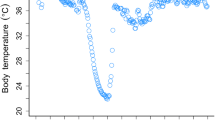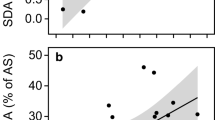Abstract
The Dungeness crab, Cancer magister, inhabits areas that are frequently subject to periods of hypoxia. This species can employ physiological mechanisms that allow it to cope with acute hypoxic episodes. When crabs feed there is a general increase in physiological variables; these may pose an additional physiological burden on crabs already attempting to maintain adequate oxygen uptake in hypoxia. In Barkley Sound, British Columbia, the inshore habitats of C. magister ranged in dissolved oxygen from 28 kPa at the water surface to less than 1.0 kPa just above the sediment–water interface. During short-term hypoxic events, crabs reduced both the amount of food eaten and the amount of time spent feeding. Crabs tended to cease feeding below 3.2 kPa oxygen, but resumed feeding when the dissolved oxygen tensions were rapidly raised to 6 kPa. In a high (10.5–21 kPa) oxygen gradient, both unfed and fed crabs showed no preference for any area of the gradient. In a low (2.5–10.5 kPa) dissolved oxygen gradient, both unfed and fed crabs preferred the highest oxygen regime. In the laboratory, crabs were less likely to enter hypoxic waters (below 3.2 kPa oxygen) to obtain and consume food; those that did moved the food to a higher oxygen regime prior to feeding and settled in higher oxygen regimes for digestion. Crab behaviour was also monitored in the field. Fed and unfed crabs were fitted with ultrasonic telemetry tags and tracked during a tidal cycle. Unfed crabs remained mobile, travelling up to 1,370 m within 6 h, while postprandial crabs settled in areas of high oxygen and moved very little during the first 48 h after release. The present study suggests that C. magister exhibits behavioural responses in order to minimise the use of physiological mechanisms, and maximise foraging and digestive processes. Thus the nutritional state of the individual may be important in regulating both its behaviour and distribution in its natural environment.





Similar content being viewed by others
References
Airriess CN, McMahon BR (1994) Cardiovascular adaptations enhance tolerance of environmental hypoxia in the crab Cancer magister. J Exp Biol 190:23–41
Ansell AD (1973) Changes in oxygen consumption, heart rate and ventilation accompanying starvation in the decapod crustacean Cancer pagurus. Neth J Sea Res 7:455–475
Bell GW, Eggleston DB, Wolcott TG (2003a) Behavioral responses of free-ranging blue crabs to episodic hypoxia. I. Movement. Mar Ecol Prog Ser 259:215–225
Bell GW, Eggleston DB, Wolcott TG (2003b) Behavioral responses of free-ranging blue crabs to episodic hypoxia. II. Feeding. Mar Ecol Prog Ser 259:227–235
Bennett AF, Hicks JW (2001) Postprandial exercise: prioritization or additivity of the metabolic responses? J Exp Biol 204:2127–2132
Bernatis JL (2005) Feeding and digestion in Dungeness crabs in hypoxia. MS thesis, University of Nevada, Las Vegas
Bernatis JL, McGaw IJ (2004) Feeding and digestion in the Dungeness crab, Cancer magister, in hypoxic conditions. Soc Integr Comp Biol 43:857–857
Brante A, Hughes R (2001) Effect of hypoxia on the prey-handling behaviour of Carcinus maenas feeding on Mytilus edulis. Mar Ecol Prog Ser 209:301–305
Butler P, Taylor E, McMahon B (1978) Respiratory and circulatory changes in the lobster (Homarus vulgaris) during long term exposure to moderate hypoxia. J Exp Biol 73:131–146
Das T, Stickle W (1993) Sensitivity of crabs Callinectes sapidus and Callinectes similis and the gastropod Stramonita haemastoma to hypoxia and anoxia. Mar Ecol Prog Ser 98:263–274
Das T, Stickle W (1994) Detection and avoidance of hypoxic water by juvenile Callinectes sapidus and Callinectes similis. Mar Biol 120:593–600
Diaz R, Rosenberg R (1995) Marine benthic hypoxia: a review of its ecological effects and behavioural responses of benthic macrofauna. Oceanogr Mar Biol 33:245–303
Fu SJ, Xie XJ, Cao ZD (2005) Effect of meal size on postprandial response in southern catfish (Silurus meridionalis). Comp Biochem Physiol 140A:445–451
Hagerman L (1998) Physiological flexibility: a necessity for life in anoxic and sulphidic habitats. Hydrobiologia 375/376:241–254
Hicks JW, Bennett AF (2004) Eat and run: prioritization of oxygen delivery during elevated metabolic states. Respir Physiol Neurobiol 144:215–224
Hill AD, Taylor AC, Strang RH (1991) Physiological and metabolic responses of the shore crab Carcinus maenas (L.) during environmental anoxia and subsequent recovery. J Exp Mar Biol Ecol 150:31–50
Johansson B (1997) Behavioural response to gradually declining oxygen concentration by Baltic Sea macrobenthic crustaceans. Mar Biol 129:71–78
Larimer JL (1964) Sensory-induced modifications of ventilation and heart rate in crayfish. Comp Biochem Physiol 12:25–36
Legeay A, Massabuau J (1999) Blood oxygen requirements in resting crab (Carcinus maenas) 24 h after feeding. Can J Zool 77:784–794
Legeay A, Massabuau J (2000) The ability to feed in hypoxia follows a seasonally dependent pattern in shore crab Carcinus maenas. J Exp Mar Biol Ecol 247:113–129
Lowrey TA, Tate LG (1986) Effect of hypoxia on hemolymph lactate and behavior of the blue crab Callinectes sapidus Rathbun in the laboratory and field. Comp Biochem Physiol 85A:689–692
Massabuau JC (2001) From low arterial to low tissue oxygenation. An evolutionary theory. Respir Physiol 128:249–261
McGaw IJ (2001) Impacts of habitat complexity on physiology: purple shore crabs tolerate osmotic stress for shelter. Estuarine Coast Shelf Sci 53:865–876
McGaw IJ (2005a) Does feeding limit cardiovascular modulation in the Dungeness crab Cancer magister during hypoxia? J Exp Biol 208:83–91
McGaw IJ (2005b) Burying behaviour in two sympatric crab species Cancer magister and Cancer productus. Sci Mar 69:375–381
McGaw IJ (2006) Prioritization or summation of events? Physiological responses of postprandial Dungeness crabs in low salinity. Physiol Biochem Zool 79:169–177
McGaw IJ, McMahon BR (2003) Balancing tissue perfusion demands: cardiovascular dynamics of Cancer magister during exposure to low salinity and hypoxia. J Exp Zool 295A:57–70
McGaw IJ, Reiber CL (2000) Integrated physiological responses to feeding in the blue crab Callinectes sapidus. J Exp Biol 203:359–368
McMahon B (2001) Control of cardiovascular function and its evolution in Crustacea. J Exp Biol 204:923–932
McMahon B, Wilkens J (1975) Respiratory and circulatory responses to hypoxia in the lobster Homarus americanus. J Exp Biol 62:637–655
Mente E, Legeay A, Houlihan DF, Massabuau JC (2003) Influence of oxygen partial pressure on protein synthesis in feeding crabs. Am J Physiol Regul Integr Comp Physiol 284:R500–R510
Mistri M (2004) Effects of hypoxia on predator–prey interactions between juvenile Carcinus aestuarii and Musculista senhousia. Mar Ecol Prog Ser 275:211–217
Pihl L, Baden S, Diaz R, Schaffner L (1992) Hypoxia-induced structural changes in the diet of bottom-feeding fish and Crustacea. Mar Biol 112:349–361
Rabalais NN, Turner RG, Wiseman WJ (2001) Hypoxia in the Gulf of Mexico. J Environ Qual 30:320–329
Reiber C (1995) Physiological adaptations of crayfish to the hypoxic environment. Am Zool 35:1–11
Reiber CL, McMahon BR (1998) The effects of progressive hypoxia on the crustacean cardiovascular system: a comparison of the freshwater crayfish (Procambarus clarkii) and the lobster (Homarus americanus). J Comp Physiol 168:168–176
Robertson RF, Meagor J, Taylor EW (2002) Specific dynamic action in the shore crab, Carcinus maenas (L.), in relation to acclimation temperature and to the onset of the emersion response. Physiol Biochem Zool 75:350–359
Sagasti A, Schaffner L, Duffy J (2001) Effects of periodic hypoxia on mortality, feeding and predation in an estuarine epifaunal community. J Exp Mar Biol Ecol 258:257–283
Sneddon LU, Huntingford FA, Taylor AC (1998) Impact of an ecological factor on the costs of resource acquisition: fighting and metabolic physiology of crabs. Funct Ecol 12:808–815
Stevens BG, Armstrong DA, Cusimano R (1982) Feeding habits of the Dungeness crab Cancer magister as determined by the index of relative importance. Mar Biol 72:135–145
Taylor EW (1982) Control and co-ordination of ventilation and circulation in crustaceans: responses to hypoxia and exercise. J Exp Biol 100:289–319
Taylor EW, Butler PJ (1973) The behaviour and physiological responses of the shore crab Carcinus maenas during changes in environmental oxygen tension. Neth J Sea Res 7:496–505
Taylor EW, Butler PJ (1978) Aquatic and aerial respiration in the shore crab, Carcinus maenas (L.), acclimated to 15°C. J Comp Physiol 127B:315–323
Taylor DL, Eggleston DB (2000) Effects of hypoxia on an estuarine predator–prey interaction: foraging behaviour and mutual interference in the blue crab Callinectes sapidus and the infaunal clam prey Mya arenaria. Mar Ecol Prog Ser 196:221–237
Taylor EW, Butler PJ, Al-Wassia A (1977) Some responses of the shore crab, C. maenas (L.) to progressive hypoxia at different acclimation temperatures and salinities. J Comp Physiol B 122:391–402
Von Herbing IH, White L (2002) The effects of body mass and feeding on metabolic rate in small juvenile Atlantic cod. J Fish Biol 61:945–958
Wallace JC (1973) Feeding, starvation and metabolic rate in the shore crab Carcinus maenas. Mar Biol 20:277–281
Wang T (2001) Physiological consequences of feeding in animals. Comp Biochem Physiol 128A:395–396
Wang T, Burggren WW, Nobrega E (1995) Metabolic ventilatory and acid base responses associated with specific dynamic action in the toad Bufo marinus. Physiol Zool 68:192–205
Wilkes PRH, McMahon BR (1982) Effect of maintained hypoxic exposure on the crayfish Orconectes rusticus. 1. Ventilatory, acid-base and cardiovascular adjustments. J Exp Biol 98:119–137
Zou E, Du N, Lai W (1996) The effects of severe hypoxia on lactate and glucose concentrations in the blood of the Chinese freshwater crab Eriocheir sinensis (Crustacea: Decapoda). Comp Biochem Physiol 114A:105–109
Acknowledgements
We thank the director and staff of Bamfield Marine Sciences Centre for use of facilities. We also thank C. Cross, for statistical advice and P. Schulte for helpful comments while preparing the manuscript. This work was supported by a grant from the National Science Foundation to IJM (IBN #0313765). All experiments were carried out at the Bamfield Marine Sciences Centre and complied with the Canadian Animal Use Protocol.
Author information
Authors and Affiliations
Corresponding author
Additional information
Communicated by R.J. Thompson, St. John´s.
Rights and permissions
About this article
Cite this article
Bernatis, J.L., Gerstenberger, S.L. & McGaw, I.J. Behavioural responses of the Dungeness crab, Cancer magister, during feeding and digestion in hypoxic conditions. Mar Biol 150, 941–951 (2007). https://doi.org/10.1007/s00227-006-0392-3
Received:
Accepted:
Published:
Issue Date:
DOI: https://doi.org/10.1007/s00227-006-0392-3




